Existing Home EnerGuide Home Evaluations

Existing Home EnerGuide Home Evaluations
Planning to access the Canada Greener Homes Grant or Loan?
Getting an EnerGuide Home Evaluation to access the Canada Greener Homes Initiative? Contact us to be put in touch with an Energy Advisor in your area.
Why complete an EnerGuide Home Evaluation?
An EnerGuide Home Evaluation with our experienced energy advisors provides you with expert advice and a customized retrofit plan so that you can:
- save money on your energy bills
- improve your home’s health and comfort
- reduce your home’s environmental impact.
- save hours of planning and thousands of dollars by assisting you to make energy upgrade decisions that are right for your home and budget.
- gain access to the Canada Greener Homes Grant and Canada Greener Homes Loan
- become eligible for the Home Energy Improvement Bonus for completing three or more energy efficiency upgrades, offered by the CleanBC Better Homes and Home Renovation Rebate Program.
EnerGuide Home Evaluations follow a standardized process developed by Natural Resources Canada to provide homeowners with comprehensive and unbiased recommendations for their homes. Your local government or financial institution may provide discounts or rebates for evaluations.
Read more about EnerGuide Home Evaluations in our FAQs below.
Contact us to be put in touch with an Energy Advisor in your area!
Contact UsCheck out the incentives available for your energy efficiency upgrades.
Featured Incentives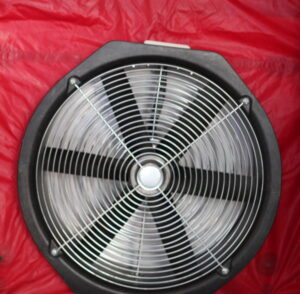
A Service Organization is an independent organization licensed by Natural Resources Canada to deliver federal housing programs, such as the EnerGuide Rating System.
Service organizations work with builders, energy advisors, and homeowners across Canada to assess the energy performance and potential energy savings for homes during the design, construction, and renovation stages.
City Green is a licensed Service Organization and works with energy advisors throughout BC. As a Service Organization, City Green provides quality assurance, training, and technical support to our energy advisors. All of these activities work to maintain the integrity of the EnerGuide Rating System.
An energy advisor has completed the qualifications required by NRCan to deliver EnerGuide rating services for eligible homes in Canada. Energy advisors have demonstrated knowledge in:
- EnerGuide Rating System
- Residential construction practices for low-rise housing
- Energy efficiency renovation practices
- Building science
- Basic arithmetic, geometry and computers skills
- Data collection requirements
- Energy simulation modeling using HOT2000, and
- Good client relations
An energy advisor must complete a series of exams, and become affiliated with a service organization in order to be licensed by NRCan.
Energy advisors may choose to work on new homes, existing homes, or both.
An EnerGuide home evaluation is a comprehensive service provided by an unbiased energy advisor to assess your home’s energy performance and determine which areas of your home can be improved to help lower your utility bills and make your home more comfortable. Your energy advisor will complete a site visit, talk to you about concerns about the home, renovation plans, priority areas, rebates and create an energy model of your home.
- Your energy advisor will take measurements of your home and assess your home's insulation levels, windows and doors, space and water heating systems, and ventilation.
- Your advisor will conduct a blower door test which tests the air leakage of the home. The blower door test is a depressurization test that slightly depressurizes the home so that air is drawn into the home through tiny cracks and gaps. While the fan is running, you can walk through the home with your energy advisor and find all the air leakage spots. You'd be surprised at all the hidden leaks!
- Your energy advisor will perform a safety check called an Exhaust Depressurization Test to determine whether conditions exist that could cause your home's exhaust systems to pull dangerous gases into the home. Your energy advisor will let you know if you are at risk and will provide guidance on who you can contact to fix it.
- After your energy advisor has completed the assessment and tests, they will talk to you about priorities, concerns, issues, or renovation plans you may have for your home. They will also discuss relevant rebates that may apply to your specific goals or renovations.
- After the evaluation, your energy advisor will create an energy model based on the site visit. Within 2 weeks of your evaluation, you will receive a Renovation Upgrade Report, a Homeowner Information Sheet, and an EnerGuide Label.
You may choose to complete a post-retrofit evaluation to learn how your home's energy efficiency has improved since you finishing renovations. Completing a post-retrofit evaluation after completing renovations is also the gateway to accessing some of the energy efficiency rebates available.
- Your energy advisor will return to your home and check your home's energy performance after completing upgrades and renovations.
- Your energy advisor will document the changes in your home since your pre-retrofit evaluation and create an updated energy model of your home. The data will be used to generate an updated EnerGuide Rating, EnerGuide Label, and Homeowner Information Sheet.
If you are planning to access rebates, ensure that you have all of the necessary documentation for your application at this stage. If you are selling your home, consider including your EnerGuide rating in the listing for your home to show a third-party verified confirmation of your home's efficiency.
Discover Energy Solutions for Your Whole Home
- Your home works as a system. All elements of your home - insulation, mechanical systems, building envelope etc. - affect each other. Have an energy evaluation done based on a whole-home approach to find the best energy efficiency solution for the whole home.
- Improve indoor air quality and comfort.
- Lower your energy consumption and energy bills by installing high-efficiency products in your home.
- Lower the greenhouse gas emissions of your home and your environmental footprint and help achieving our climate targets.
- Explore solutions for energy efficiency issues such as drafts, molds, stuffiness, outside noise etc.
Prioritized & Unbiased Upgrade Recommendations
- Our energy advisors are licensed with Natural Resources Canada and provide comprehensive and impartial service.
- Speak with our energy advisors about the best options for your house to meet your specific goals for your home.
- Talk to our advisors about your priorities and let them identify upgrade options for accessing rebates, reducing energy bills, improving home comfort, reducing your carbon footprint, improving your home's resale value, insulating your home from outside noise, or addressing other home issues related to energy efficiency.
Receive Money for Your Upgrades
- Understand the rebate program criteria and options.
- Become eligible for financing like low-interest loans and reduced mortgage premiums.
- Access the Canada Greener Homes Grant and/or additional rebates available through the the CleanBC Better Homes and Home Renovation Rebate Program.
EnerGuide is the official mark of the Government of Canada for its energy performance rating and labeling program for houses, light-duty vehicles, and certain energy-using products. EnerGuide Ratings are available for new home construction and for existing homes.
The EnerGuide rating is the modeled energy consumption of a home, measured in gigajoules per year. The lower the rating, the less energy a home consumes. The EnerGuide Rating is displayed on the EnerGuide Label, which provides summarized information from the energy evaluation. It includes:
- EnerGuide Rating
- A typical new house reference: the EnerGuide Rating the home would have if it had been built to current building code.
- Breakdown of the rated annual energy consumption
- Greenhouse gas emissions: the estimated GHGs emitted annually as a result of using energy in the home.
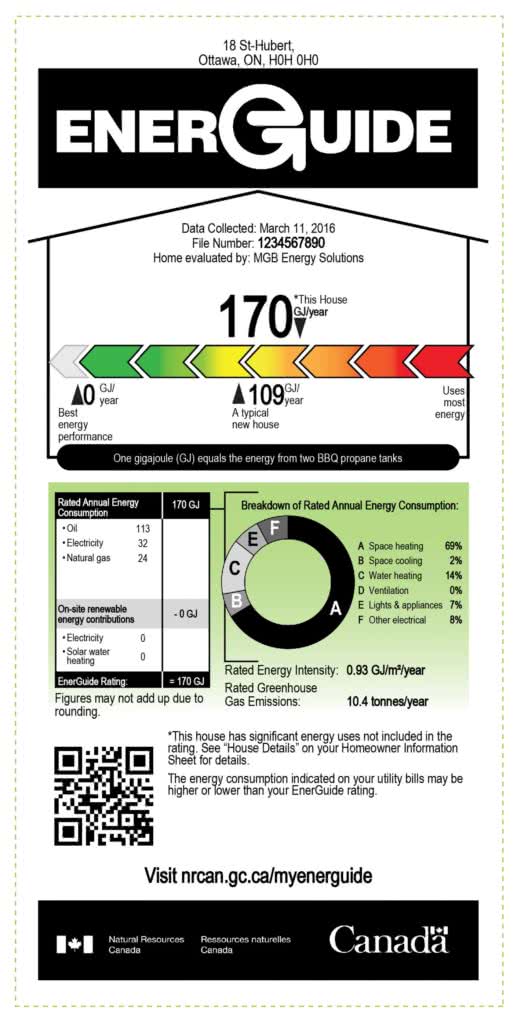
For more information on the EnerGuide Label, check the Guide to the EnerGuide Label.
A blower door test is used to measure the air tightness of your home. One blower door test takes about 30 minutes to complete.
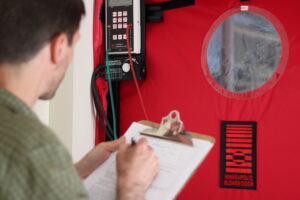
Your energy advisor will set up a blower door fan in an exterior door that depressurizes the home by sucking air out. To equalize the pressure difference between inside and outside, outdoor air will flow into the home through all cracks, holes and gaps in your building envelope. While the blower door fan is running the energy advisor will walk through the home to take notes of all leaky areas that you should focus on when draftproofing. Feel free to join your advisor. You may be surprised by all leaks in your house!
The data from the blower door test is used for the energy model. Your home will receive an air leakage score in Air Changes per hour at a 50 Pascal pressure difference - that means the amounts of time the whole home air volume is replaced per hour when the home is depressurized. The Equivalent Air Leakage Area that you can find on the Homeowner Information Sheet shows the size of a hole that is equivalent to the accumulated size of all cracks and gaps in your home in square cm and square inches.
Is the Blower Door Test Dangerous for Me or My Pets?
You can safely remain in your home during a blower door test. The fan does create some noise that may scare some pets.
- Do not start any renovations or demolition work before your evaluation (e.g. removing drywall, windows, siding, cabinets, bathtubs, HVAC systems, etc.).
- Ensure your home is in a habitable condition as defined by Natural Resources Canada, including:
- Space and water heating systems must be on site at the time of the evaluation. The heating system has to be (or have been in the case of a broken system) capable of heating the home to 21°C.
- The building envelope must be in a suitable condition for a blower door test. Ceilings, exterior walls, foundation walls, exposed floors, interior finish (e.g. drywall), windows, doors, and skylights must be intact/in place.
- The building envelope must be in a suitable condition for a blower door test. Exterior walls, foundation walls, exposed floors, ceilings, interior drywall, windows, doors, and skylights must be intact.
- Close all exterior openings to prepare for the blower door test. This includes windows and doors, fireplace dampers, crawlspace and attic hatches.
- Sweep out your fireplace, close the damper, remove any valuables around your fireplace and do not have a fire within 24 hours of the evaluation. Having a fire within 24 hours of the evaluation is a safety hazard to the advisor and anyone in the residence.
- If you are concerned that soot might be drawn into your home, please consider having your chimney swept before your evaluation, and/or covering rugs and removing valuables from around your fireplace.
- Pilot lights of an oil or gas furnace may be extinguished during the blower door test. It is your responsibility to arrange the relighting.
- Your Energy Advisor will take photographs of mechanical systems, insulation levels, windows, and the exterior of the home to meet Natural Resources Canada quality assurance requirements.
- Have your property tax bill and/or roll number available for your energy advisor. This number is required to verify the legal homeowner of the property.
- During the evaluation we collect your personal information and will request your consent to share the information with Natural Resources Canada and program partners through the Evaluation Authorization Form.
- Ensure your energy advisor has access to all areas and mechanical systems in the home, including any suites, the attic, basement or crawlspace, heating system, water heating system, and windows and doors.
- For your post-retrofit evaluation, ensure all your renovations are completed and that you have photocopies of required documentation for the rebates.
Vermiculite is a type of insulation that may contain asbestos fibres and is commonly found in older homes with insulation installed prior to 1990. If you suspect that there is vermiculite in your home, it is highly recommended that you take precautionary measures due to serious potential health risks. If exposed, asbestos fibres can become airborne in the home’s interior and cause serious harm if inhaled. For more information about the risks associated with asbestos exposure, please visit Health Canada.
If you discover vermiculite in your home, do not disturb it. Contact a certified asbestos removal specialist that will follow BC hazardous waste regulations for options in relation to your renovations. For information about asbestos testing and having it removed professionally, please visit Work Safe BC.
If you have vermiculite in your home that may be (or become) exposed to the interior, the blower door test will not be performed, and instead you will be requested to sign the Blower Door Test Waiver. By signing this waiver you acknowledge that your EnerGuide rating will likely not be as accurate as it would have been had a blower door test been performed.
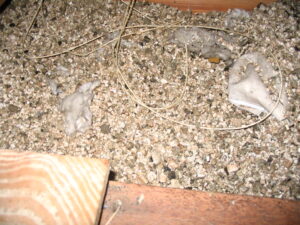
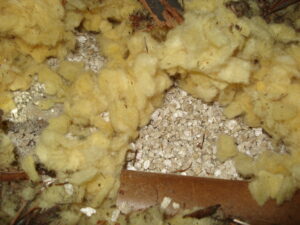
Vermiculite insulation in attic